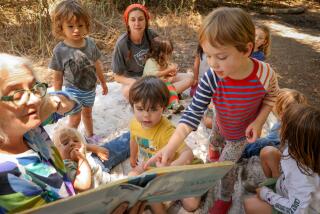Watch Out and Learn
- Share via
Ah, wilderness. Kids in at least two Orange County elementary schools on the ragged edge of exurbia regularly get a taste of it--in the form of baby rattlesnakes, hawks and other unexpected visitors from the wild.
Children at El Morro Elementary School in Laguna Beach, which abuts the rugged hills of Crystal Cove State Park, were warned off the playground this week after a number of baby rattlers were spotted in the grass. Some parents are sure the grading for a new development on nearby slopes is driving the snakes to the school grounds, but Principal Joanne Culverhouse and area park rangers said it was more likely coincidence.
“Basically, it was pretty typical for this area,” said Culverhouse, who said snake sightings have been reported as long as the school has been open--more than 30 years.
“Any time you have development, no matter where it’s at, you’re going to disrupt the natural community,” said Crystal Cove State Park Ranger David Ruger. “Either you kill them by burying them, or if they’re mobile enough, they get out of the way. But that project is still several hundred yards away from the school--I would put it all off to coincidence.”
The wildlife can provide both an opportunity for up-close science education and a danger to students: Rangers said baby rattlesnakes can be more dangerous than adults, both because they do not have fully developed rattles to alert humans to their presence and because they tend to inject all of their venom rather than just part of it.
A custodian and a parent killed snakes with shovels this week. One was discovered on the playground Tuesday, and two more were spotted in the middle of the Violent Vipers soccer team practice the next day.
But an ingenious teacher has turned the snakes into an object lesson, lining a wall with the skins for nature lessons, as well as preserving a tarantula, snake spines, a dragonfly and other fauna. One of the snakes killed this week is now being dried out by fourth-graders as a gift for their principal.
“I love the snakes,” said Danny, 8, a fourth-grader in Kathy Vick’s class. “We get to learn about how their habitats are, how they eat, how they live, all that.”
Other children said they had enjoyed dissecting one of the snakes to find its poison sacks.
“It’s absolutely a good learning experience,” said Ranger Barbara Norton of the Laguna Coast Wilderness Park, who nonetheless cautioned that it would be preferable not to kill the snakes but to call animal control or to capture and release the creatures back into the wild. “El Morro is surrounded by wilderness, you know. . . . We’re all one community--the plants, the animals and we as human beings.”
Ruger said: “If you’re living in a area that borders on natural habitat, release [the animal] back into a natural world. They were there first. They are a vital part of the food chain. . . . If you kill a snake, you kill something that might have taken care of dozens of mice and rats.”
At Silverado Elementary School, near the border of the Cleveland National Forest, the custodian patrols every hot morning for potentially lethal creatures like snakes, making sure to check under buildings and around the outdoor lunch area where they might be drawn by rodents.
And “the PTA has taxidermied two hawks” that were scraped up from the busy canyon road in front of the school, said Principal Lee Green. “One of our PTA gals is a bit of a naturalist. If they see some hawk injured out on the side of the road they get it help, but if they’re . . . road kill . . . then she takes ‘em up to a taxidermist. He does a real nice job. . . .
“We have a little nature center out back. You know, I really think it is neat that our kids get to live out here in a natural environment.”
Parents at El Morro agreed.
“It’s part of nature,” said Gay Penney of Laguna Beach, whose third-grader was one of the kids who spotted the rattlesnake on the soccer field. “It teaches them to have respect for the animals. They learn they have to live with them, and be careful of them.”
Rangers Ruger and Norton cautioned that children should not attempt to play with or bother the snakes--or any wild animals. Students at both elementary schools are told regularly to report any snake sighting to an adult immediately.
(BEGIN TEXT OF INFOBOX / INFOGRAPHIC)
Rattlesnake Precautions
Warmer weather has increased snake activity in Orange County. A look at the rattlesnake and some safety tips:
RATTLER FACTS
* Average length: 5 to 6 feet
* Habitat: Rocky areas, especially in deserts and foothills.
* Hibernation: Late November to February
* Habits: Likes to bask in sun; won’t bite unless threatened; young rattlers tend to release all their venom when they bite, making them more dangerous than older snakes.
* If bitten: Don’t panic. Keep bit below heart level. Seek medical help immediately.
WHEN THEY BITE
When biting, snakes open their mouths wide and release venom through their hollow fangs. Venom primarily attacks the nervous system, but could affect the heart and circulatory system.
HOW THEY HISS
The rattle is made of keratin, the same substance that forms human hair and nails. When shaken, the loosely locked rattles rub against each other, producing a hissing sound audible up to 100 feet away.
Source: “Field Guide to Western Reptiles and Amphibians.”
More to Read
Sign up for Essential California
The most important California stories and recommendations in your inbox every morning.
You may occasionally receive promotional content from the Los Angeles Times.













